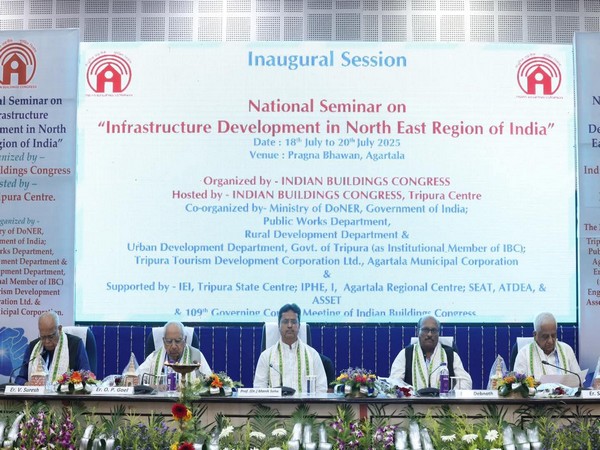Dharamshala (Himachal Pradesh) [India], January 14 (ANI): China’s intensified control over Tibet has made it increasingly difficult for Tibetans to escape to India. In 2024, only eight Tibetans managed to flee to Dharamshala, a significant decline from over 40 in 2023 and the 3,000 who crossed into India annually from the 1990s to 2008.
According to Sikyong Penpa Tsering, President of the Tibetan government-in-exile, the sharp decline in Tibetan arrivals is attributed to increased Chinese control following the 2008 uprising. Tsering also pointed to demographic shifts in Tibet, noting that there are fewer children due to reduced family sizes.
Speaking to ANI, President of the Tibetan government-in-exile, Sikyong Penpa Tsering said, “Just like any other community, the Tibetan diaspora community is also facing a lot of social and demographic change. One reason is, of course, from 1959-60 people proceeded or followed His Holiness the Dalai Lama–about 80-85 thousand Tibetans who came to India, Nepal, and Bhutan. Then till about the early 80s, there was no movement from Tibet at all, and from the early 80s onwards, some Tibetans were coming out during Hua Guofeng’s time, and then from the 90s and year 2000, there were quite many Tibetans coming out up to 2008. We used to receive any number between 2,500 to 3,500 Tibetans every year. Most of them were young children who were left behind to study in India, not knowing whether they would be able to meet their families again or not.”
This drastic decline has resulted in the Tibetan Reception Centre in Khaniyara village near Dharamshala standing largely vacant. The dwindling influx of Tibetans has also impacted Tibetan Children’s Village (TCV) schools in exile, with some reporting no new admissions last year and one school in Dharamshala on the verge of closure.
Some Tibetan schools reported no new admissions last year, and one school in Dharamshala is reportedly on the verge of closure.
“After the 2008 uprising in Tibet, there was more control inside Tibet, and there may be other reasons why those things are happening. After Xi Jinping came into power, the control over the whole of China, more particularly over the Tibetan people, has been very strong, and even small variables like tourist guides who have been bringing these people over the Himalayas by taking money–have also been removed from Lhasa, as a lot more pressure on the Nepalese government,” said Tsering.
“There are fewer children in Tibet now because earlier, you could have 4, 5, or 6 children, and there were people who could look after the parents, and some people could go and join the monastery. Now the number of children has come down to 2 or 3, so there may be a multiplicity of reasons why the numbers are going down, affecting our community here,” he added.
Tsering noted that the dispersal of Tibetan communities has posed a challenge to preserving cultural identity. “The compact community that was started by His Holiness the Dalai Lama in consultation with Pandit Nehru at that time… has helped over the last 65 years in preserving our identity in terms of language, culture, arts, and crafts and dance forms and all kinds of things. So now that is getting affected. One of our objectives is also how to repopulate the compact community, and this programme is called building back compact communities–how to bring back people to the settlements,” he said.
Addressing initiatives in the Tibetan diaspora, Tsering highlighted efforts in Western countries to create new compact communities. “The larger number of Tibetans are in North America, Europe, Australia–all these countries. So there have been some initiatives from some Tibetans, particularly in Manasota, where we are talking about at least 3,000 to 5,000 Tibetans. They are planning to acquire about 80 acres of land to accommodate about 300 families where the compact Tibetan communities [can thrive]. Another group is also planning to open a charter school for Tibetans. These are new ecosystems within the Tibetan community,” he said.
Tsering reflected on the Tibetan diaspora’s progress, noting that it has reached a mature level, with many Tibetans establishing themselves in Western countries. He believes that establishing new Tibetan compact communities in these countries could set an example for other Tibetan communities.
Tsering added, “Now it has been over 30 years since the first lot of one thousand Tibetans moved to the United States. Now it multiplies to several thousands, and most of them have bought their houses, and paid their mortgages. They have reached a stage, and their children have grown up there with those kinds of education.”
He continued, “I think our community has reached a mature level where we can establish new Tibetan compact communities in Western countries. So if this is successful, this could set an example for other Tibetan communities where there are larger numbers of Tibetans to establish similar compact communities in this free world.” (ANI)
Disclaimer: This story is auto-generated from a syndicated feed of ANI; only the image & headline may have been reworked by News Services Division of World News Network Inc Ltd and Palghar News and Pune News and World News
HINDI, MARATHI, GUJARATI, TAMIL, TELUGU, BENGALI, KANNADA, ORIYA, PUNJABI, URDU, MALAYALAM
For more details and packages
















